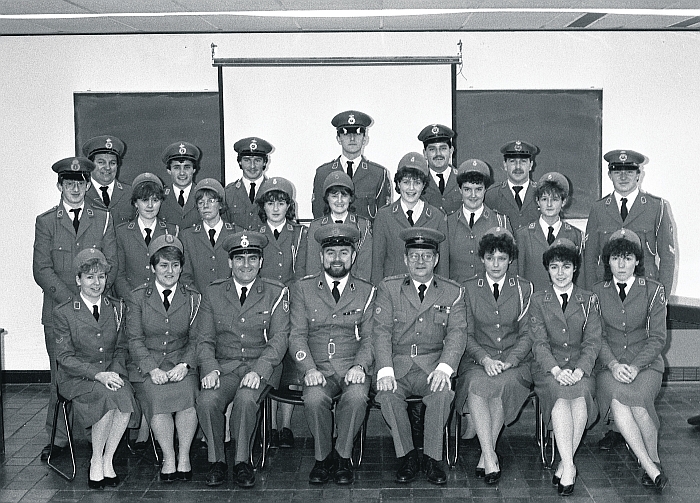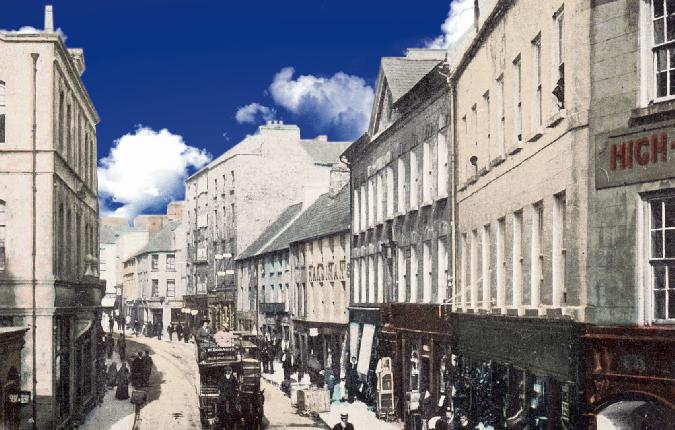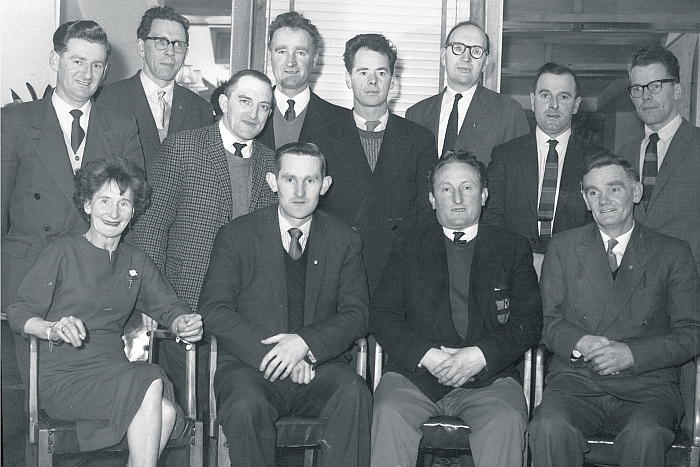Archive News
March 28, 2013

Date Published: 27-Mar-2013
1913
Killed by runaway horse
On Monday, a young man named J. Egan attended the fair at Castlerea to sell a saddle horse. He failed to sell it, and when about to return home, the horse dashed across St. Patrick Street and into the shop of a man named Caulfield.
Egan, who was on the animal’s back, was caught by the top of the door, and thrown to the footway, where he lay unconscious. He died soon afterwards in Castlerea Hospital from fracture of the spine.
United Irish League
In Letterfrack, a largely attended meeting was held at the League room on Sunday – in fact, it was so large that a great number, unable to find room in the hall, had to stand outside the door and windows, and follow the proceedings as best they could.
From a condition seemingly incurable of apathy and indifference, the people around Tullycross have awakened to their own interests with a bound. Not since the stirring days of the Land League have the people been so insistent in their demand for the distribution of grazing farms.
They know the surest way to secure the land is by clinging together, and fighting together, under the banner of a progressive battling organisation, the same as the Letterfrack branch now is.
1938
Unemployment allotments
Thirty-four unemployment allotment plots have been again allotted this year in St. Grellan’s and St Brennan’s Terraces, Ballinasloe, at the nominal fee of 1s. per year.
For the shilling rent, the allotment holder is provided with garden tools, spades, etc., and free seeds, manures and spraying material. The two years’ experiment in these allotment plots in Ballinasloe have proved their utility to the unemployed, materially and morally; materially as they provide food and vegetables for his family, and morally, as they provide healthy employment for the holder, when otherwise he may be spending his time in idleness.
It has also been found that, with the exception of one or two cases, all the plots have been tilled and the yield of vegetables from them has been good. One man, it was stated, in a recent discussion on these plots, sold over £2 worth of vegetables in the market. Competition among the unemployed is also keen for these plots.
Connemara tourism
With the approach of this year’s tourist season in Connemara, preparations are being made throughout the area in anticipation of a greater influx of tourists. Extensions and improvements have been made at Mongan’s Hotel, Carna; the Railway Hotel, Clifden; McKeown’s Hotel, Leenane and several other hotels in Connemara. The proprietors of the Corrib Hotel, Oughterard, have purchased an additional premises and a new hotel is being opened by Mr. William Lavelle, Clifden.
At a meeting of the Clifden Tourist Development Association last week, a long discussion took place on the condition of the Clifden beach road, and it was decided to ask the I.T.A. to use its good offices with the Local Government and County Council in having the road repaired.
The beach is to Clifden what Salthill is to Galway. It is the walk and drive most favoured by visitors, and leads to the sea and bathing places. In its present condition, however, it serves more as a punishment than as a pleasure to those who use it, to the torment of their feet and at danger to their lives.
For more, read this week’s Connacht Tribune.
Galway in Days Gone By
The way we were – Protecting archives of our past

People’s living conditions less than 100 years ago were frightening. We have come a long way. We talk about water charges today, but back then the local District Councils were erecting pumps for local communities and the lovely town of Mountbellew, according to Council minutes, had open sewers,” says Galway County Council archivist Patria McWalter.
Patria believes we “need to take pride in our history, and we should take the same pride in our historical records as we do in our built heritage”. When you see the wealth of material in her care, this belief makes sense.
She is in charge of caring for the rich collection of administrative records owned by Galway County Council and says “these records are as much part of our history as the Rock of Cashel is. They document our lives and our ancestors’ lives. And nobody can plan for the future unless you learn from the past, what worked and what didn’t”.
Archivists and librarians are often unfairly regarded as being dry, academic types, but that’s certainly not true of Patria. Her enthusiasm is infectious as she turns the pages of several minute books from Galway’s Rural District Councils, all of them at least 100 years old.
Part of her role involved cataloguing all the records of the Councils – Ballinasloe, Clifden, Galway, Gort, Loughrea, Mountbellew, Portumna and Tuam. These records mostly consisted of minutes of various meetings.
When she was cataloguing them she realised their worth to local historians and researchers, so she decided to compile a guide to their content. The result is For the Record: The Archives of Galway’s Rural District Councils, which will be a valuable asset to anybody with an interest in history.
Many representatives on these Councils were local personalities and several were arrested during the political upheaval of the era, she explains.
And, ushering in a new era in history, women were allowed to sit on these Rural District Councils – at the time they were not allowed to sit on County Councils.
All of this information is included in Patria’s introductory essay to the attractively produced A4 size guide, which gives a glimpse into how these Rural Councils operated and the way political thinking changed in Ireland during a short 26-year period. In the early 1900s, these Councils supported Home Rule, but by 1920, they were calling for full independence and refusing to recognise the British administration.
“I love the tone,” says Patria of the minutes from meetings. “The language was very emotive.”
That was certainly true of the Gort Rural District Council. At a meeting in 1907, following riots in Dublin at the premiere of JM Synge’s play, The Playboy of the Western World the councillors’ response was vehement. They recorded their decision to “protest most emphatically against the libellous comedy, The Playboy of the Western World, that was belched forth during the past week in the Abbey Theatre, Dublin, under the fostering care of Lady Gregory and Mr Yeats. We congratulate the good people of Dublin in howling down the gross buffoonery and immoral suggestions that are scattered throughout this scandalous performance.
For more from the archives see this week’s Tribunes here
Archive News
Galway have lot to ponder in poor show

Date Published: 23-Jan-2013
SLIGO 0-9
GALWAY 1-4
FRANK FARRAGHER IN ENNISCRONE
GALWAY’S first serious examination of the 2013 season rather disturbingly ended with a rating well below the 40% pass mark at the idyllic, if rather Siberian, seaside setting of Enniscrone on Sunday last.
The defeat cost Galway a place in the FBD League Final against Leitrim and also put a fair dent on their confidence shield for the bigger tests that lie ahead in February.
There was no fluke element in this success by an understrength Sligo side and by the time Leitrim referee, Frank Flynn, sounded the final whistle, there wasn’t a perished soul in the crowd of about 500 who could question the justice of the outcome.
It is only pre-season and last Sunday’s blast of dry polar winds did remind everyone that this is far from summer football, but make no mistake about it, the match did lay down some very worrying markers for Galway following a couple of victories over below par third level college teams.
Galway did start the game quite positively, leading by four points at the end of a first quarter when they missed as much more, but when Sligo stepped up the tempo of the game in the 10 minutes before half-time, the maroon resistance crumbled with frightening rapidity.
Some of the statistics of the match make for grim perusal. Over the course of the hour, Galway only scored two points from play and they went through a 52 minute period of the match, without raising a white flag – admittedly a late rally did bring them close to a draw but that would have been very rough justice on Sligo.
Sligo were backable at 9/4 coming into this match, the odds being stretched with the ‘missing list’ on Kevin Walsh’s team sheet – Adrian Marren, Stephen Coen, Tony Taylor, Ross Donovan, David Kelly, David Maye, Johnny Davey and Eamon O’Hara, were all marked absent for a variety of reasons.
Walsh has his Sligo side well schooled in the high intensity, close quarters type of football, and the harder Galway tried to go through the short game channels, the more the home side bottled them up.
Galway badly needed to find some variety in their attacking strategy and maybe there is a lot to be said for the traditional Meath style of giving long, quick ball to a full forward line with a big target man on the edge of the square – given Paul Conroy’s prowess close to goal last season, maybe it is time to ‘settle’ on a few basics.
Defensively, Galway were reasonably solid with Gary Sice at centre back probably their best player – he was one of the few men in maroon to deliver decent long ball deep into the attacking zone – while Finian Hanley, Conor Costello and Gary O’Donnell also kept things tight.
For more, read this week’s Connacht Tribune.
Archive News
Real Galway flavour to intermediate club hurling battle in Birr

Date Published: 23-Jan-2013
images/files/images/x3_Courthouse.jpg












